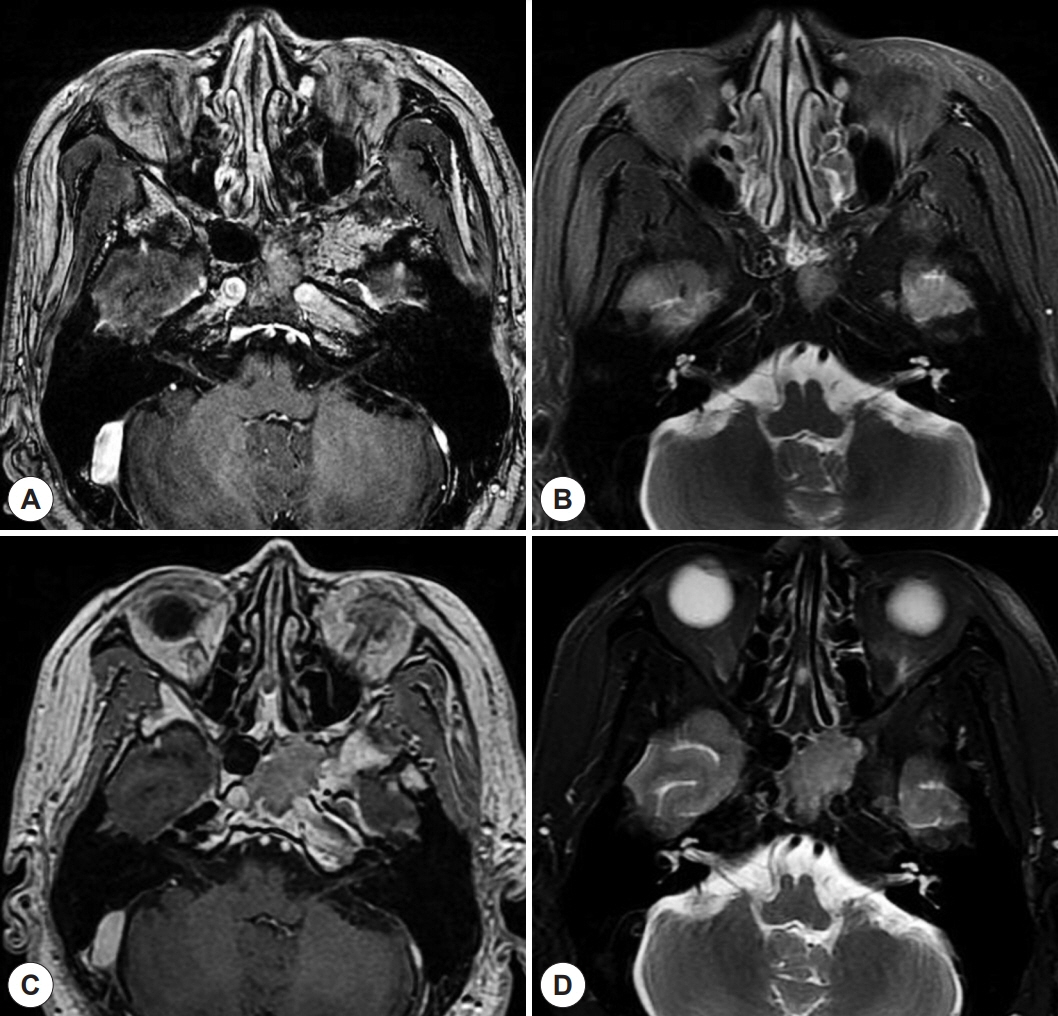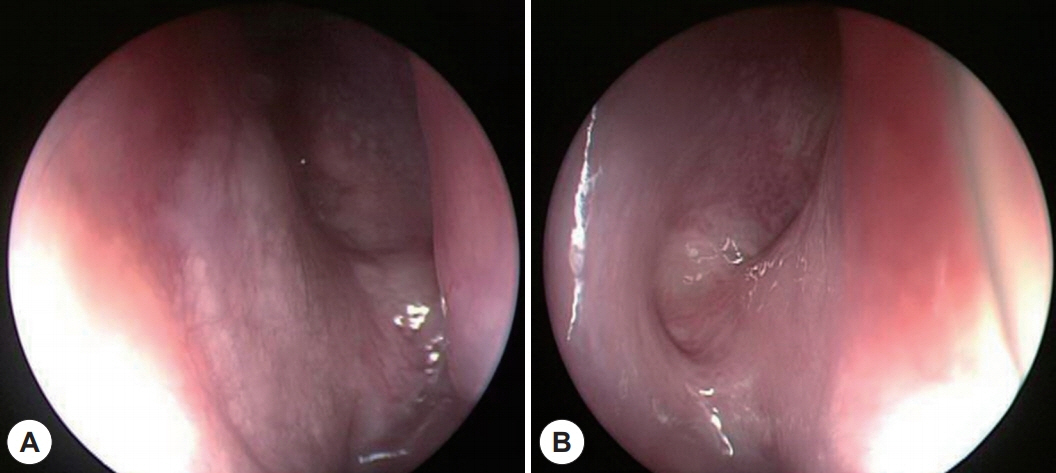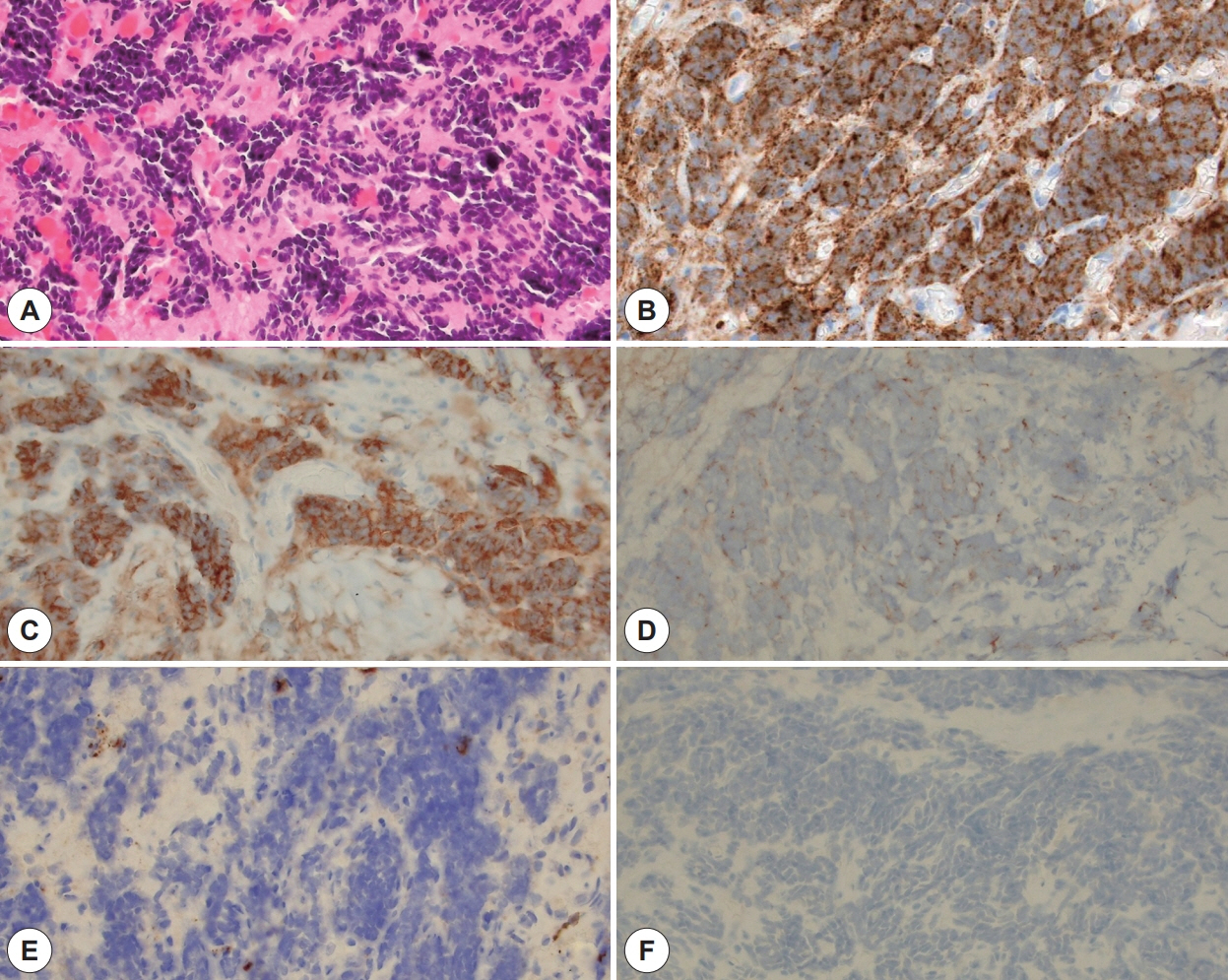J Rhinol.
2021 Jul;28(2):110-115. 10.18787/jr.2021.00351.
A Case of Small Cell Carcinoma Originated from Sphenoid Sinus in Patient with Recurrent Pituitary Tumor
- Affiliations
-
- 1Department of Otorhinolaryngology-Head and Neck Surgery, Dong-A University, College of Medicine, Busan, Korea
- 2Department of Pathology, Dong-A University, College of Medicine, Busan, Korea
- KMID: 2518677
- DOI: http://doi.org/10.18787/jr.2021.00351
Abstract
- Small cell carcinoma (SmCC) is a type of neuroendocrine tumor commonly originating in the lung, with only about 2-4% of cases arising at extrapulmonary sites. Extrapulmonary SmCC of the head and neck has a poor prognosis and a high rate of distant metastasis. The paranasal sinus is a rare location for extrapulmonary SmCC and only a few related papers have been published to date. We report a rare case of SmCC originating from the sphenoid sinus in a patient with a recurrent pituitary tumor with a literature review.
Keyword
Figure
Reference
-
References
1. Pointer KB, Ko HC, Brower JV, Witek ME, Kimple RJ, Lloyd RV, et al. Small cell carcinoma of the head and neck: An analysis of the National Cancer Database. Oral Oncol. 2017; 69:92–8.2. Kim YS, Bae CH, Song SY, Kim YD. A case of a small cell neuroendocrine carcinoma of the nasal septum. Korean J Otorhinolaryngol-Head Neck Surg. 2009; 52(6):529–32.3. Wakasaki T, Yasumatsu R, Masuda M, Matsuo M, Tamae A, Kubo K, et al. Small Cell Carcinoma in the Head and Neck. Ann Otol Rhinol Laryngol. 2019; 128(11):1006–12.4. Raychowdhuri RN. Oat-cell carcinoma and paranasal sinuses. J Laryngol Otol. 1965; 79:253–5.5. Yeo SC, Cho HJ, Kim SW, Jeon SY. A case of small cell carcinoma of the maxillary sinus coexisting with fungus ball. J Rhinol. 2016; 23(2):110–4.6. Ha SY, An HJ, Cho KW, Yoo CY, Cho JH, Kim SH, et al. A case of small cell carcinoma of the maxillary sinus with distant metastasis. Korean J Med. 2015; 88(6):719–23.7. Koo BM, Kim HG, Cho H, Park P. A Case of Delayed Diagnosis of Small Cell Carcinoma Originated from the Maxillary Sinus with Bilateral Fungal Sinusitis. Korean J Otorhinolaryngol-Head Neck Surg. 2020; 63(6):276–81.8. Nagaishi M, Suzuki K, Sugiura Y, Takano I, Tanaka Y, Hyodo A. Undifferentiated sarcoma of the sphenoid sinus. Auris Nasus Larynx. 2018; 45(2):388–91.9. Ma ATW, Lei KIK. Small cell neuroendocrine carcinoma of the ethmoid sinuses presenting with generalized seizure and syndrome of inappropriate antidiuretic hormone secretion: a case report and review of literature. Am J Otolaryngol. 2009; 30(1):54–7.10. Kang JM, Lee HY, Lee KS, Ko SY. Small Cell Neuroendocrine Carcinoma of the Nasal Cavity: a case report. Korean J Otorhinolaryngol-Head Neck Surg. 2003; 46(2):164–7.11. Bishop JA, Guo TW, Smith DF, Wang H, Ogawa T, Pail SI, et al. Human papillomavirus-related carcinomas of the sinonasal tract. Am J Surg Pathol. 2013; 37(2):185–92.12. Nour YA, Al-Madani A, El-Daly A, Gaafar A. Isolated sphenoid sinus pathology: spectrum of diagnostic and treatment modalities. Auris Nasus Larynx. 2008; 35(4):500–8.13. Qingqiang Zhu, Wenrong Zhu, Jingtao Wu, Hongying Zhang. The CT and MRI observations of small cell neuroendocrine carcinoma in paranasal sinuses. World J Surg Oncol. 2015; 13:54.14. Naier Lin, Meng Qi, Zhengyue Wang, Siqi Luo, Yucheng Pan, Fang Zhang, et al. Small Cell Neuroendocrine Carcinoma of Paranasal Sinuses: Radiologic Features in 14 Cases. J Comput Assist Tomogr. 2021; 45(1):135–41.15. Babin E, Rouleau V, Vedrine PO, Toussaint B, de Raucourt D, Malard O, et al. Small cell neuroendocrine carcinoma of the nasal cavity and paranasal sinuses. J Laryngol Otol. 2006; 120(4):289–97.
- Full Text Links
- Actions
-
Cited
- CITED
-
- Close
- Share
- Similar articles
-
- Sphenoid Sinus Mucocele Complicated With Spontaneous CSF Rhinorrhea: Case Report
- Sphenoid Sinus Mucocele(Case Report)
- Ectopic Pituitary Adenoma within the Sphenoid Sinus
- Isolated Inverted Papilloma of the Sphenoid Sinus Presenting as Ptosis
- A Case of Compressive Optic Neuropathy Caused by Sphenoid Sinus Mucocele





